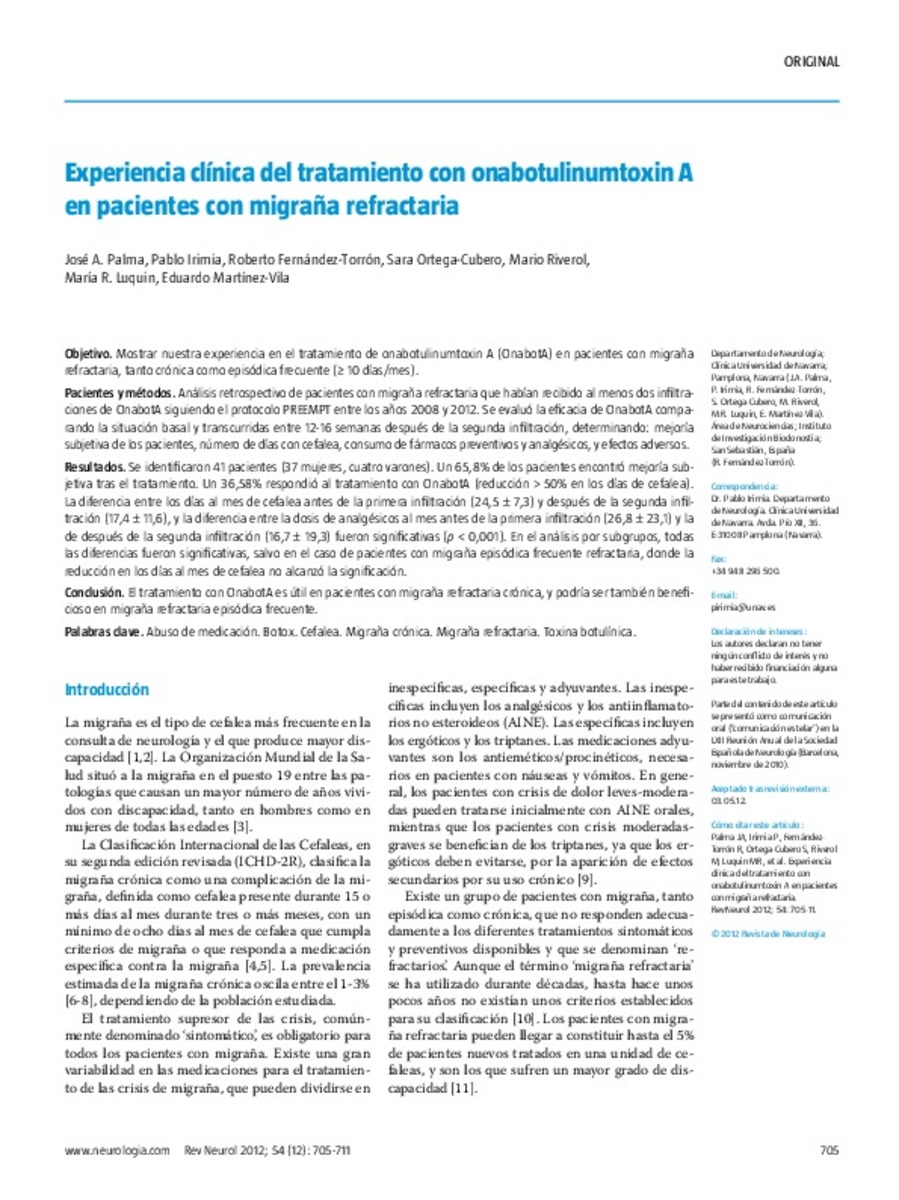Registro completo de metadatos
| Campo DC | Valor | Lengua/Idioma |
|---|---|---|
| dc.creator | Palma, J.A. (José Alberto) | - |
| dc.creator | Irimia, P. (Pablo) | - |
| dc.creator | Fernandez-Torron, R. (Roberto) | - |
| dc.creator | Ortega-Cubero, S. (Sara) | - |
| dc.creator | Riverol, M. (Mario) | - |
| dc.creator | Luquin, M.R. (María Rosario) | - |
| dc.creator | Martinez-Vila, E. (Eduardo) | - |
| dc.date.accessioned | 2012-07-02T11:11:01Z | - |
| dc.date.available | 2012-07-02T11:11:01Z | - |
| dc.date.issued | 2012 | - |
| dc.identifier.citation | Palma JA, Irimia P, Fernandez-Torron R, Ortega-Cubero S, Riverol M, Luquin MR, et al. Experiencia clínica del tratamiento con onabotulinumtoxin A en pacientes con migraña refractaria. Rev Neurol 2012 Jun 16;54(12):705-711. | es_ES |
| dc.identifier.issn | 0210-0010 | - |
| dc.identifier.uri | https://hdl.handle.net/10171/22769 | - |
| dc.description.abstract | To analyse our experience in the treatment of refractory chronic migraine, episodic frequent refractory migraine (>= 10 days/month), with onabotulinumtoxin A (OnabotA). PATIENTS AND METHODS. Retrospective analysis of patients with refractory migraine who underwent, at least two sessions of OnabotA pericranial injections following the PREEMPT protocol between 2008 and 2012. The efficacy of OnabotA was evaluated comparing the basal situation with 12-16 weeks after the second session. We analysed the subjective improvement of the patients, number of days with headache, preventive and abortive drugs consumption, and adverse effects. RESULTS. Forty-one patients (37 women, 4 male) were identified. 65.8% patients experienced subjective improvement after OnabotA treatment. 36.58% responded (reduction of > 50% in headache days). Differences between days with headache before the first session (24.5 +/- 7.3), and 12-16 weeks after the second session (17.4 +/- 11.6), as well as the differences between the number of abortive drugs taken before the first session (26.8 +/- 23.1) and 12-16 weeks after the second session (16.7 +/- 19.3), were statistically significant (p < 0.001). Subgroups analysis showed that all differences were significant, except for the reduction of the number of days with headache in patients with episodic frequent refractory migraine. CONCLUSION. Our work shows that treatment with OnabotA is safe and useful in patients with episodic and chronic refractory migraine, including those patients with medication overuse headache. | es_ES |
| dc.language.iso | spa | es_ES |
| dc.publisher | Viguera | es_ES |
| dc.rights | info:eu-repo/semantics/openAccess | es_ES |
| dc.subject | Onabotulinumtoxin | es_ES |
| dc.subject | Refractory migraine | es_ES |
| dc.title | Experiencia clínica del tratamiento con onabotulinumtoxin A en pacientes con migraña refractaria | es_ES |
| dc.type | info:eu-repo/semantics/article | es_ES |
| dc.relation.publisherversion | http://www.neurologia.com/pdf/Web/5412/bh120705.pdf | es_ES |
| dc.type.driver | info:eu-repo/semantics/article | es_ES |
Ficheros en este ítem:
Estadísticas e impacto
Los ítems de Dadun están protegidos por copyright, con todos los derechos reservados, a menos que se indique lo contrario.






